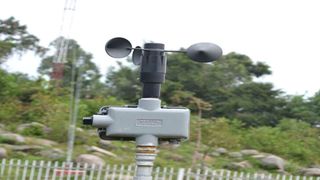
Weather forecast equipment at the Nganyi shrine in Vihiga County.
| File | Nation Media GroupNews
Premium
Why weatherman is predicting rain but hot sun comes up
Kenyans could be depending on unreliable weather forecast information to make critical decisions following revelations that the Kenya Meteorological Department (Met) has been using obsolete technology to collect data.
Auditor-General Nancy Gathungu’s report on the Ministry of Environment and Forestry cautions that the department must replace the manual technology it is currently using with digital technology.
In the report’s part flagging the weatherman’s use of “outdated equipment and technology”, Ms Gathungu notes that audit inspections at the Dagoretti Corner Station in November last year revealed, among others, that the automatic rain gauge and sunshine recorder were not functional.
“It was not clear how the department captures data for the affected parameters for the station’s reporting area. Further, the audit revealed that the department has not fully installed modern digital equipment and technology and relies on old manual systems for weather reporting,” the auditor stated.
Met, which provides weather forecasts for the country regularly, is relied on by millions of Kenyans to make decisions in areas such as agriculture, transport and academic purposes, making the credibility of the data it relays essential.
Outdated equipment
Ms Gathungu’s report indicates that even as the weatherman relies on archaic technology, Sh47 million worth of digital equipment that could support its work has been lying idle at its stores.
She notes that using the old technology could be affecting reliability of the data, processes of capturing it and time taken to relay weather forecasts.
“The management should consider overhauling the existing manual technology system and replace it with digital technology so as to enhance reliability and effectiveness of the processes of monitoring, capturing and timely dissemination of weather forecasts to stakeholders,” the Auditor-General observed.
She noted that while the ministry had contracted a firm to supply, deliver, test and commission digital weather instruments comprising of 60 digital barometers, thermometers and humidity sensors, 60 digital weather monitoring and display processing systems and three rugged laptops, they had never been utilised by November during the physical verification exercise.
High-altitude areas
They were delivered in April 2021 and had been kept in the stores.
“Information available indicates that the delay is due to lack of power UPS which must be installed alongside the equipment. It was not clearly explained why the procurement omitted such an essential component for the installation. Consequently, the value for money from the payment of Sh47 million could not be confirmed,” the report stated.
At the department’s website yesterday, among weather forecasts shared for public consumption was one predicting how things would be between March 15 and 21 (yesterday).
The seven-day forecast projected that rainfall was expected over the Highlands West of the Rift Valley as well as over a few areas in the Highlands East of the Rift Valley and the South-eastern lowlands.
“The rest of the country is likely to be mainly sunny and dry. Daytime (maximum) temperatures are likely to be generally high. Night time (minimum) temperatures are likely to be low over high-altitude areas,” the weather forecast noted.
Met, in a March 15-21 forecast, also projected that in Embu light morning/afternoon showers were expected between March 15 and 18, in Manyatta and Runyenjes sub-counties. Residents have, however, not experienced rains yet.





